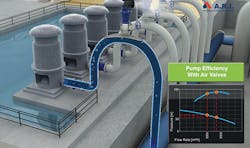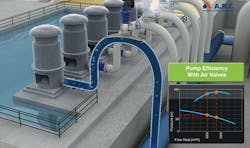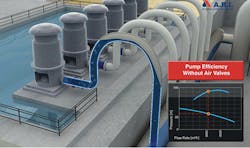Maximizing Your Energy Savings Potential with Air Valves
WaterConnections
Presented by A.R.I. Flow Control Accessories
Water and wastewater systems throughout the United States combine pump stations, gravity flow, and numerous piping layouts that vary in total system efficiency, reliability, and longevity. Pumps and piping systems are often integrated into municipal operations over a period of several years, and sometimes even decades. This approach often results in systems that are mismatched, suboptimal, and lack overall maintenance and operational efficiency.
Piping schemes also typically have wide fluctuations in elevation, pressures, and flow rates. Because of these variables, air pockets get trapped in the pipeline and create additional friction and head losses. These contribute to lower flows and longer pump running times, which result in higher energy consumption at the pump.
Maintenance costs are also increased as longer run times increase pump wear and shorten the maintenance cycle. Pockets of compressed air also multiply the pressure transient events (up-surge and down-surge) that occur countless times each day and result in pipe bursts, pipe collapses, and massive shocks to the entire system and its components.
It is estimated that accumulated air in pipelines alone increases pumping costs at least 10 percent in virtually every pump and pipeline system.
A.R.I.’s proprietary ARIavCAD software can help you analyze your planned or existing pipeline and maximize your energy efficiency by helping you size and place your valves effectively.
Properly sizing and installing air valves, such as those provided by A.R.I., have been proven to reduce air and gases trapped within pipelines. Consequently, it can dramatically reduce energy costs as pump run times are decreased, and the energy required to pump the same volume of water or wastewater is reduced as the air/gas is evacuated.
A.R.I.’s proprietary ARIavCAD software can help you analyze your planned or existing pipeline and maximize your energy efficiency by helping you size and place your valves effectively. WW
A.R.I. Flow Control Accessories LTD manufactures and markets a complete line of air valves, check valves, control valves and unmeasured flow reducers (UFR), and provides software system analyses for surge and air valve sizing and placement. To learn more, visit www.arivalves.com.


